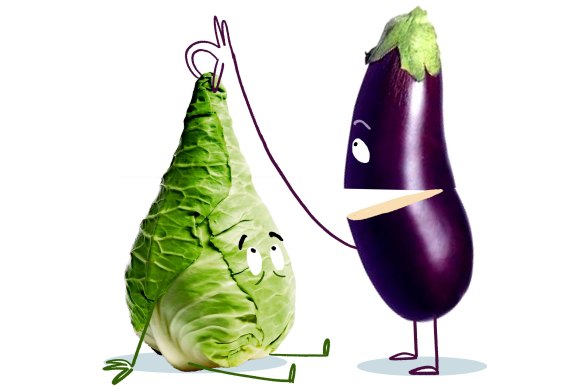Don’t like cabbage? This sweet, buttery and beautiful variety might change your mind
How does a simple fruit or vegetable emerge from nowhere to build its own niche brand, asks Terry Durack.
It starts with “What’s that?” There’s something on the menu that you’ve never heard of. Do you bluff it – or cry for help? I cry for help.
It could be chulpi, beni imo or ooray, all of which I’ve come across on menus in the past seven days. “What’s that?” I ask, and they tell me that it’s Ecuadorean roasted corn or Japanese purple sweet potato or an Indigenous name for Davidson plum.
Related Article
The real story, though, is the journey these ingredients take from those first pioneering steps on a menu to being household names. From being exotic and rare (for some, at least) to becoming shopping-list staples.
In the 1940s, before the postwar waves of European, Asian and Middle Eastern migration, eggplant was little-known in Australia. Then it started sneaking onto market stalls and menus. Now it’s “Pick up some eggplant for me? We’re having moussaka tonight.”

How does it work – that a simple fruit or vegetable can emerge from nowhere to build its own niche brand?
Enterprising growers and market-stall holders are usually the first stop. Chefs, eager to work with something new and exciting, will pick up on it. Diners like us turn up and say, “What’s that?” and then like it enough to want to cook it at home. If we’re lucky, this word-of-mouth food chain will complete itself and a “passing fad” becomes more available.
The power of word-of-mouth has changed dramatically, however, from the over-the-fence chats of old to today’s social-media whirlwinds. Suddenly, something – butter boards, feta pasta, Salt Bae – is all over TikTok and the next day, it’s gone. (If you haven’t heard of any of these, you probably looked away from your phone for a minute and a half.)
Related Article
Take the hispi cabbage, also known as sweetheart cabbage or pointed cabbage for its charming, conical shape. It’s sweet, buttery and beautiful and doesn’t smell like, you know, cabbage.
Already much-loved in Europe and the UK, the hispi has done the hard yards here at farmers’ markets and top restaurants, but never quite cracked social media.
Bring back word-of-mouth, I say. Talk it up. If you see it, buy two and give one to a friend. With any luck, they’ll take one look at it and say, “What’s that?”
theemptyplate@goodweekend.com.au
Related Article
Related Article
Continue this edition
The May 11 EditionUp next

Good Weekend Superquiz and Saturday Target Time, May 11
Trivia buffs: test your knowledge with today's interactive superquiz and target.
Previous

‘Tough economic climates are temporary, but community is forever’: Why Gemini is a gem
This crowd-funded cafe, bar, restaurant and pantry has changed Coburg for the better. If you’re local, you’re lucky.
The best recipes from Australia's leading chefs straight to your inbox.
Sign up



